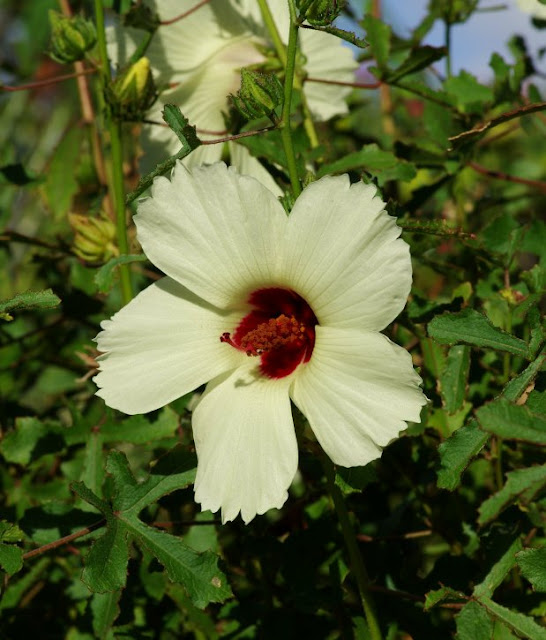Hibiscus aculeatus is a perennial hibiscus native to the southeastern United States coastal plain in North Carolina, South Carolina, Georgia, Florida, Alabama, Mississippi, and Louisiana, as well as in Hardin County, Texas. In late winter or spring, it produces thick, somewhat woody, ascending to erect stems with alternate, deeply lobed, roughly hairy leaves. It begins to flower soon thereafter and can continue flowering so long as moist to wet conditions prevail. The flowers are comparatively large—note that they are larger than the leaves—and are very showy as a result of their pale yellow to creamy white color with a contrasting maroon-red eye. If pollinated by bees, butterflies, or hummingbirds, they are soon followed by rather large capsules that are covered with coarse, sharp hairs.
As is apparent from its common name, pineland hibiscus frequently occurs in wet pine flatwoods, but it is also found in bogs, savannas, and roadside ditches. Unlike many other southeastern United States hibiscus, it often occurs where there is no permanent standing water and perhaps this is the reason that it is the easiest of southeastern native hibiscus to grow under ordinary garden conditions in a perennial border. Hibiscus aculeatus is extremely drought tolerant and, under adverse conditions, will produce only one or two short stems; however, under ideal conditions, it will form a large, bushy mass with many stems up to 3 feet (0.9 meters) tall and about as wide or wider. Self-sown seedlings have been few and welcomed in my dryish garden but I would imagine that it would spread from seed far more aggressively if provided with continually moist soil in sunny, open areas free from taller competing plants. In autumn or early winter, the deceptively woody stems die back to the ground and, in formal garden situations, will need to be cut down, otherwise, it requires no other maintenance. It is not particularly bothered by pests except the occasional aphid or scale, but rarely to any serious extent. Due to its ease of cultivation and value in attracting bees, butterflies, and hummingbirds, it is a welcome addition to the garden and is recommended wherever one can provide a moist, sunny spot for this attractive and easily grown hibiscus.
In Florida, Hibiscus aculeatus occurs throughout the panhandle as well as much of northern Florida, from which it extends south to Lake County. In spite of its northern distribution, it is remarkably adaptable and my original plant, first placed in the ground in February 1996, is still with me, more than 16 years later, in my southern Florida garden. Another common name for Hibiscus aculeatus is comfort root, this being an allusion to the soothing, comforting qualities of its mucilage-containing roots.
Images and text © 2012 Rufino Osorio


1 comment:
Your style is unique compared to other people I've read stuff from. Many thanks for posting when you have the opportunity, Guess I'll just book mark this site.
Look at my blog post ... Great Massage
Post a Comment